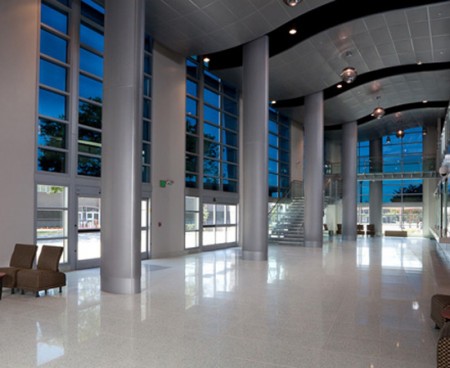By Steven Ashley, Txchnologist
When you walk into a darkened room, usually you flip on the lights or open the shades. But soon you could opt instead to let the sunshine in by hitting a switch to send an electrical current coursing through your windows.
Smart window technology, thermally insulating fenestration that changes color at the flip of a switch, is the next wave in windows. Smart glass’ most visible application right now is in the auto-dimming rearview mirrors in high-end cars. But the technology is poised to move out of the Mercedes and into homes and businesses, where it could potentially save one-eighth of all the energy used by buildings in the U.S. if it replaced all the conventional windows in the country, according to researchers at the National Renewable Energy Laboratory (NREL) in Golden, Colo. That’s about 5 percent of the nation’s entire energy budget.

Such huge savings are possible because standard, clear windows leak heat on chilly days and allow sunlight to warm rooms excessively on hot ones, forcing buildings’ heating and air conditioning systems to work overtime. Smart windows can let in the sun to help heat rooms when it’s cold outside or block the visible and near-infrared light that can overheat houses in the summer. They can also reduce the need for electric lighting during daytime and partially eliminate the need for shades and blinds.
Smart, Green, but Costly
Smart, or dynamic, window technology can turn glass from transparent to translucent (usually blue or blue-gray in color) and back again when it is briefly exposed to low voltage that is fed to it via a simple circuit to the building current, thus controlling the transmission of visible and near-infrared light. The technology is not new; color-changing glass has been available for more than two decades. But it has always been a premium product that, at $50 to $100 per square foot, has been too costly for most commercial and residential construction projects.
Those prices are likely to fall significantly next year, however, when a new, higher-volume manufacturing plant in Faribault, Minn. goes on line, says Helen Sanders, vice president of technical business development for Sage Electrochromics, the oldest and largest domestic maker of smart glass. “Our new production facility will have an initial annual production capacity of 4 million square feet,” she says. “Prices of dynamic windows should drop because they’re determined principally by manufacturing volumes; there’s nothing in the technology that’s inherently costly.”
Late last year, Sage partnered with the French company Saint-Gobain, one of the world’s largest producers of building materials, to construct the new factory. Saint-Gobain plans to distribute Sage’s glass in Europe.
Meanwhile, other manufacturers of smart windows, most of which are start-ups, are reportedly also ramping up production. These suppliers include Pleotint of West Olive, Mich., Switch Materials of Vancouver, B.C., Gesimat of Berlin, Germany, EControl-Glas of Plauen, Germany, and Soladigm of Milpitas, Calif., which received a $30 million investment from several investors, including GE Energy Financial Services.* (General Electric sponsors this magazine).
Electrochromic Glass
Smart window technology is usually based on the electrochromic (EC) effect, says Satyen K. Deb, director emeritus of NREL’s Center of Basic Sciences, and co-discoverer of the EC phenomenon in transition-metal oxides. EC materials change color when their component atoms absorb an electron (reduction, in electrochemistry) or release one (oxidation). Some smart windows change color in response to light or heat.
“Electrochromic glass typically consists of a five-layer system,” Deb says. Manufacturers use various methods such as sputtering or evaporation to deposit micron-thick films of the necessary materials. “On top is a thin layer of a transparent conductor such indium-tin oxide,” he explains. “Next comes an active electrochromic layer, which is a transition-metal oxide (often, tungsten oxide) that functions as large-bandgap semiconductor.” The following layer is an electrolyte, which transports lithium ions—electron carriers—back and forth between the active EC layer, whereas the succeeding layer is a passive, lithium-rich counterelectrode. The final layer is another thin-film of a transparent conductor.
“When you apply to the stack a small electric field, say 2 to 4 volts,” Deb continues, “lithium ions travel through the electrolyte to the electrochromic layer, where they change the atoms’ oxidation state, which darkens the material.” Another short, low-voltage jolt switches the material back to full transparency.
Powering 2,000 square feet of the color-changing glass—the equivalent of more than 100 windows—would require less power than illuminating a 60-watt light bulb.
Pleotint’s smart glass product, in contrast, is based on a temperature-sensitive film that grows more opaque as it absorbs solar heat—a passive technology called thermochromism. Switch Materials’ smart windows darken in sunlight (photochromism), an effect that is reversed by sending a weak electric current through it.
“Today, the dynamic windows market is where the [now-mature] low-emissivity (low-E) windows market was when it first started years ago,” Sage’s Sanders concludes. Smart glass installations will multiply, she predicts, “as people become more familiar with the product and greater economies of scale significantly lower prices.”
* Corrected to reflect the multiple investors in Soladigm’s financing round.
![]() Editor’s Note: This news story comes to us as a cross post courtesy of Txchnologist. Author credit for the post goes to Steven Ashley.
Editor’s Note: This news story comes to us as a cross post courtesy of Txchnologist. Author credit for the post goes to Steven Ashley.